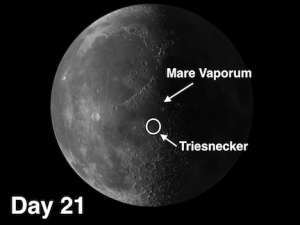 The week of November 6-12 takes us from Day 18 to the end of Day 23. You can view the Moon before midnight through Thursday. This week we will highlight the crater Triesnecker and Mare Vaporum, the Sea of Vapors, just to the S.E. of of the Apennine Mountains & viewable on Thursday evening.
The week of November 6-12 takes us from Day 18 to the end of Day 23. You can view the Moon before midnight through Thursday. This week we will highlight the crater Triesnecker and Mare Vaporum, the Sea of Vapors, just to the S.E. of of the Apennine Mountains & viewable on Thursday evening.
Triesnecker: [NE/J10] This crater is located in Sinus Medii (Central Bay), the southern portion of which is “ground zero” on the Moon (latitude 0°, longitude 0°). Triesnecker is a good illustration of what a complex crater looks like. It has a central peak, terraces, and unusually large amounts of slump material that has separated from the western rim and fallen onto the floor. This would have been a spectacular landslide, creating a wave of material that slammed all the way to the central mountain nearly 6 miles away! You can see that significant slumping has occurred on the east rim also.
Mare Vaporum: [NE/H10] If the terminator has advanced sufficiently (you may have to wait until tomorrow night) notice how there are finger-like projections extending from the back side of the Apennines into Mare Vaporum. It is not coincidental that these extensions point back to Mare Imbrium, as they are part of the ejecta that was thrown out during the initial impact. (This also makes the Sea of Vapors considerably younger than Mare Imbrium.)
======================
It is highly recommended that you get a copy of Sky and Telescope’s Field Map of the Moon, the very finest Moon map available for use at the telescope. It is available for $10.95 at www.skyandtelescope.com and on Amazon. All features mentioned in this blog will be keyed to the grid on the Field Map and will look like this: Plato: [NW/D9]
Credits:
Courtesy of Gray Photography of Corpus Christi, Texas
Lunar photos: NASA / USGS / BMDO / LROC / ASU / DLR / LOLA / Moon Globe. Used by permission
- Rupes Cauchy: A Best Known Fault on the Moon - July 22, 2024
- Moon Crater Schickard – Crater Floor has Stripes - July 15, 2024
- Moon Craters Langrenus and Vandelinus - July 8, 2024